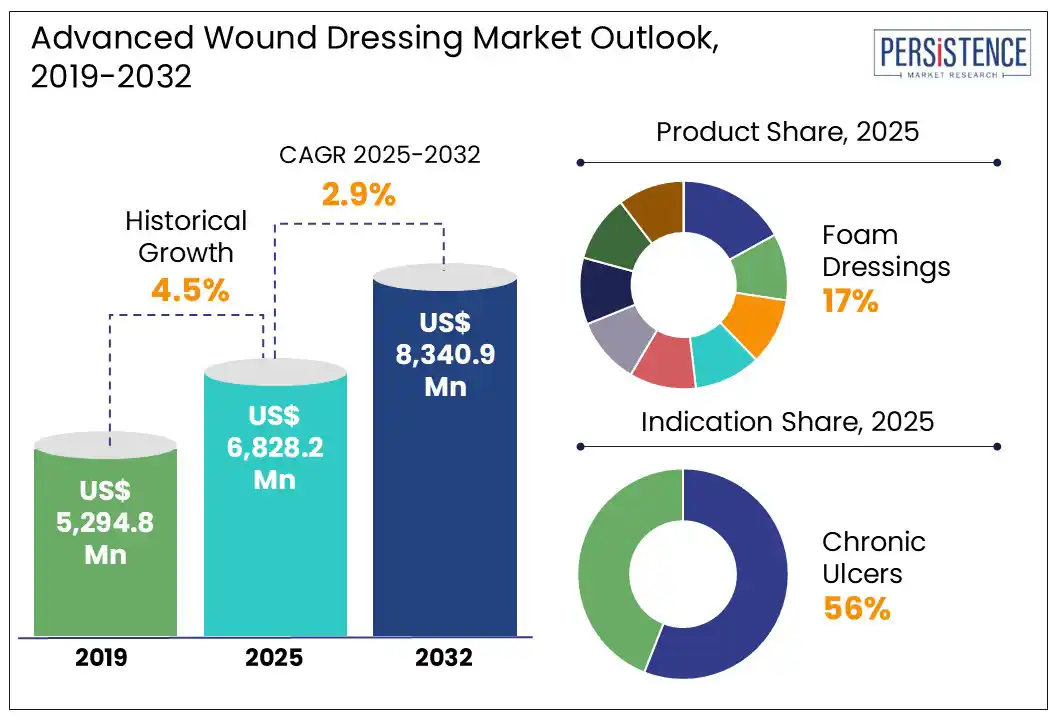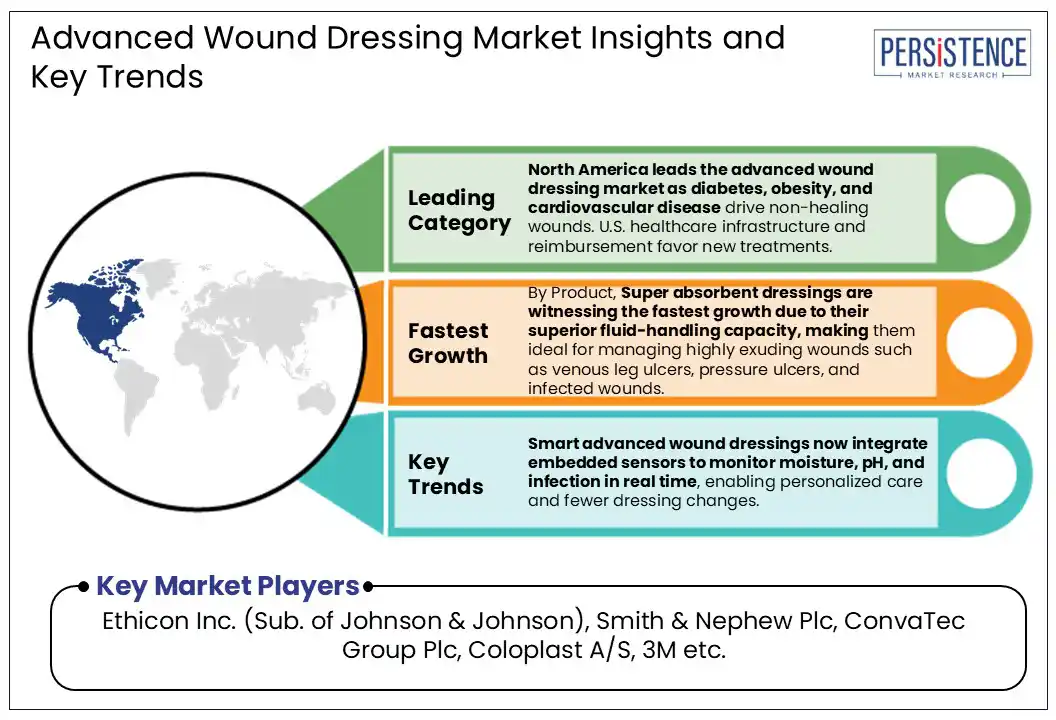ID: PMRREP31673| 202 Pages | 9 Jul 2025 | Format: PDF, Excel, PPT* | Healthcare

The global advanced wound dressing market size is likely to be valued at US$ 6,828.2 Mn in 2025, and is expected to reach US$ 8,340.9 Mn by 2032, growing at a CAGR of 2.9% from 2025 to 2032.
According to the Persistence Market Research report, the advanced wound dressing market is rapidly evolving due to the increasing incidences of chronic wounds, surgical site infections, and a globally rising geriatric population. These dressings, which include foams, hydrocolloids, alginates, and hydrofibers, offer superior moisture retention, oxygen permeability, and antimicrobial properties, thereby accelerating healing. Demand is further driven by the surge in diabetes-related ulcers and burns. Innovations such as bioactive dressings and smart wound care technologies are revolutionizing treatment protocols. Hospitals and home healthcare settings are key end users. Additionally, growing awareness around wound management and improved reimbursement frameworks in developed nations are fueling market expansion.

Key Industry Highlights:
|
Global Market Attribute |
Key Insights |
|
Advanced Wound Dressing Market Size (2025E) |
US$ 6,828.2 Mn |
|
Market Value Forecast (2032F) |
US$ 8,340.9 Mn |
|
Projected Growth (CAGR 2025 to 2032) |
2.9% |
|
Historical Market Growth (CAGR 2019 to 2024) |
4.5% |
The rising prevalence of chronic wounds has emerged as a critical driver of the advanced wound dressing market. Conditions such as diabetic foot ulcers (DFUs), venous leg ulcers, and pressure injuries are becoming increasingly common due to the global surge in diabetes, obesity, vascular disorders, and aging populations.
In India alone, DFUs affect approximately 6.2% of individuals with diabetes, underscoring a significant and growing health burden. Chronic wounds often fail to heal through conventional methods and are highly susceptible to infection, inflammation, and prolonged tissue damage. This creates a substantial clinical need for advanced dressings that maintain optimal moisture balance, enhance autolytic debridement, and deliver antimicrobial protection. Products such as foam, hydrocolloid, alginate, and hydrogel dressings are now frontline treatments in chronic wound management, offering superior exudate control and accelerated healing rates. As healthcare systems prefer early intervention and outpatient care, especially in the resource-constrained settings, demand for efficient, cost-effective, and user-friendly advanced wound care solutions continues to grow rapidly.
Advanced wound dressings often incorporate antimicrobial agents such as silver, iodine, or synthetic polymers to promote healing and prevent infection. However, these components can sometimes lead to unintended side effects, including skin irritation, allergic reactions, or cytotoxicity, particularly in patients with sensitive skin or compromised immune systems. Silver-based dressings, while widely used for their broad-spectrum antimicrobial properties, have been associated with localized burning sensations, delayed epithelialization, and discoloration of the skin in some cases.
Similarly, iodine dressings can trigger allergic responses or disrupt thyroid function with prolonged use. Synthetic polymers used in dressings may leach residual monomers or additives that provoke inflammatory responses in rare cases. These risks can reduce clinician confidence in using such products, especially when safer alternatives are available. As a result, healthcare providers often weigh the benefits against potential adverse effects, limiting the broad adoption of certain advanced wound dressings across diverse patient populations. This presents a significant restraint in market penetration.
Technology-integrated wound dressings are revolutionizing wound care by combining traditional healing materials with advanced digital capabilities. These next-generation dressings feature embedded sensors that monitor real-time parameters such as pH, temperature, moisture levels, and infection markers, providing clinicians with continuous data on wound status. This enables timely interventions, reducing complications and promoting faster healing. Some smart dressings are also equipped with controlled drug delivery systems that release antibiotics or growth factors in response to specific wound conditions, ensuring targeted therapy with minimal side effects. The convergence of digital health and biomaterials is driving innovation in this high-margin segment, attracting significant R&D investments from medical device and biotech firms. These premium-priced products are gaining traction in managing chronic and complex wounds, especially in diabetic ulcers and post-surgical care. With increasing interest from hospitals and home healthcare providers, technology-integrated dressings are poised to become a cornerstone of personalized and efficient wound management solutions.
Foam dressings hold the largest share in the advanced wound dressing market due to their exceptional versatility, absorbency, and compatibility across wound types. These dressings manage moderate to heavy exudate efficiently while maintaining a moist healing environment, which accelerates tissue regeneration. Their cushioning effect protects wounds from external trauma, making them ideal for pressure ulcers, surgical wounds, and chronic ulcers. Foam dressings are also user-friendly, often available in adhesive and non-adhesive forms, supporting both clinical and home-based care. Increasing prevalence of chronic wounds and greater adoption in aging populations further boost demand. Additionally, their integration into standard wound care protocols and favorable reimbursement policies in key regions cement their dominance in the global advanced wound care space.
Chronic ulcers account for the highest share in the advanced wound dressing market due to their widespread prevalence and persistent nature. Conditions like diabetic foot ulcers, pressure ulcers, and venous leg ulcers affect millions worldwide, especially among elderly and diabetic patients. These wounds are slow-healing, often recurring, and require long-term management, making them ideal candidates for advanced wound dressings that offer moisture control, antimicrobial protection, and enhanced healing environments. Healthcare systems prioritize treating these wounds to prevent severe complications such as infections or amputations, leading to repeated use of high-performance dressings. Additionally, specialized wound care clinics and home healthcare services are increasingly adopting advanced solutions for chronic ulcers, further contributing to their dominant market share over non-healing surgical wounds.
Institutional sales dominate the advanced wound dressing market due to the high volume of demand from hospitals, clinics, surgical centers, and long-term care facilities. These institutions frequently manage complex and chronic wounds such as diabetic foot ulcers, pressure injuries, and surgical wounds, which require advanced wound care products. Moreover, healthcare providers prefer bulk purchasing through centralized procurement systems, making institutional channels more cost-effective and logistically streamlined.

The North American advanced wound dressing market is witnessing significant growth driven by rising chronic wound prevalence, an aging population, and widespread diabetes and obesity.
In the U.S., over 6.5 million individuals suffer from chronic wounds, fueling demand for innovative wound care solutions.
Technological advancements, including smart dressings with embedded sensors and controlled drug release systems, are gaining traction. Increased healthcare spending, robust reimbursement frameworks, and the strong presence of key market players such as 3M and Smith+Nephew further strengthen the market. Additionally, the region’s emphasis on outpatient care and home healthcare is accelerating the adoption of user-friendly advanced wound dressings. Government initiatives and wound care awareness programs are also contributing to market expansion across North America.
The European advanced wound dressing market is driven by a growing geriatric population, increasing surgical procedures, and a high burden of chronic wounds, particularly pressure ulcers and venous leg ulcers. Countries like Germany, the UK, and France are leading adopters due to strong public healthcare systems and early integration of advanced wound care protocols. The region emphasizes cost-effective care, encouraging the shift from inpatient to outpatient and home-based wound management. EU regulations promoting patient safety and product innovation have led to the development of antimicrobial and bioactive dressings. Sustainability is also becoming a focus, with demand for eco-friendly wound care products growing steadily across Europe.
The Asia Pacific advanced wound dressing market is rapidly emerging due to increasing healthcare expenditure, rising diabetes prevalence, and expanding access to modern wound care in countries like China, India, and Japan. The region’s large geriatric population and surge in surgeries and trauma cases are fueling demand for efficient wound management. Governments are investing in healthcare infrastructure, particularly in tier-2 and tier-3 cities, boosting product penetration. Local manufacturers are increasingly collaborating with global players to introduce cost-effective, high-performance dressings. Japan leads in innovation, while China shows strong growth due to domestic manufacturing and policy support. Additionally, rising awareness, growing medical tourism, and the adoption of telehealth wound monitoring tools are accelerating the shift toward advanced wound care solutions in Asia Pacific.
The competitive landscape of the advanced wound dressing market is characterized by intense innovation, strong R&D investment, and a focus on expanding product portfolios. Players are competing through technological advancements, such as smart dressings with antimicrobial and moisture-balancing properties. Market participants are also prioritizing strategic collaborations, licensing deals, and regional expansion to enhance market presence. There is a rising emphasis on developing eco-friendly and bioactive wound care products to meet sustainability goals and patient demand.
The global advanced wound dressing market is estimated to increase from US$ 6,828.2 Mn in 2025 to US$ 8,340.9 Mn in 2032.
The global advanced wound care market growth is propelled by the rising prevalence of chronic wounds, such as diabetic foot ulcers and pressure ulcers, driven by aging demographics and increasing diabetes rates, plus escalating surgical procedures.
The advanced wound care market is projected to record a CAGR of 2.9% during the forecast period from 2025 to 2032.
Increasing demand for user-friendly, self-applicable dressings to support at-home chronic wound care is driving innovation and market expansion.
North America dominates the global market.
|
Report Attribute |
Details |
|
Historical Data/Actuals |
2019 - 2024 |
|
Forecast Period |
2025 - 2032 |
|
Units |
Value: US$ Mn/Bn |
|
Geographical Coverage |
|
|
Segmental Coverage |
|
|
Competitive Analysis |
|
|
Report Highlights |
|
|
Customization and Pricing |
Available upon request |
By Product
By Type
By Indication
By Distribution Channel
By Region
Delivery Timelines
For more information on this report and its delivery timelines please get in touch with our sales team.
About Author